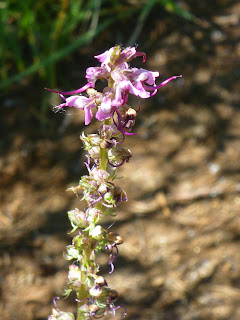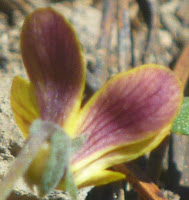John Muir refers to the western juniper (Juniperus occidentalis), a burly conifer he calls red cedar, as a stubborn wrestler unwillingly accepting its fate in rocky, high-altitude landscapes with frequent storm and avalanche exposure [1]. This extreme environment shapes alpine junipers into striking forms of odd proportions. Young trees typically show a pyramidal crown, which becomes rounded and irregular in old trees [2]. The thick branches are often curved or contorted and lichen overgrowth occurs on furrowing or dying branches in the canopy, as seen in the top picture. The smooth bark of young trees turns gray and flaky with age. John Muir writes [1]: “The bark is of bright cinnamon color, and, in thrifty trees, beautifully braided and reticulated, flaking off in thin, lustrous ribbons that are sometimes used by Indians for tent-matting.”

Western juniper seed cones (female cones) mature over a two-year period into juniper berries containing one or two seeds: the berry-like cones are initially 2 mm in diameter, growing in two seasons from purple-red to blue or purple with a glaucous bloom, subglobose to ellipsoid, fleshy or pulpy, more or less resinous, eventually dry, falling soon after ripe [2]. Mammals and birds exploit the blueberry-sized berries as food crop.
The pictures herein were made on a hike along the Pacific Crest Trail (PCT) between Ebbett's Pass and the Carson-Iceberg Wilderness. At the upper Noble Canyon, near Noble Lake, two steadfast junipers grow on granite where the PCT winds upward the eastern canyon slope, on which no other trees seem to endure.
References and more to explore
[1] John Muir: The Mountains of California. The Century Company, New York, 1894. Note: see pages 144 to 146 in the Penguin Classics Book print of 1985 with an introduction by Edward Hoagland.
[2] The Gymnosperm database: Juniper occidentalis Hooker 1838 [http://www.conifers.org/cu/Juniperus_occidentalis.php].



































